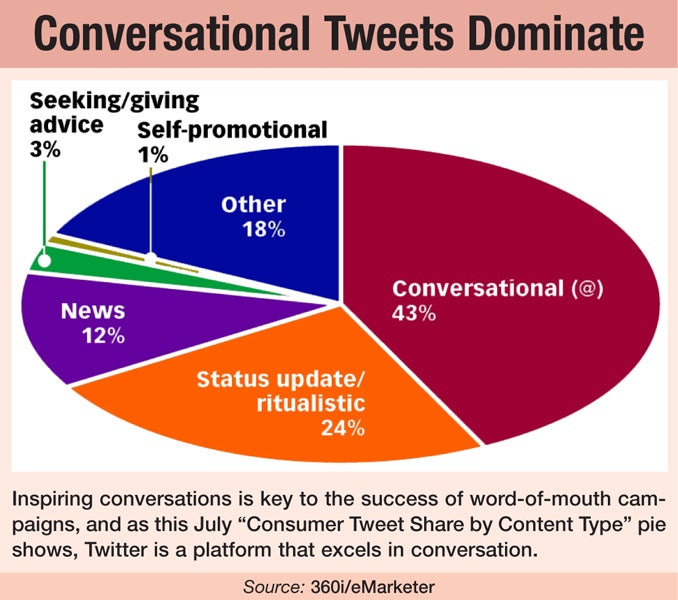Word of Mouth: Giving people a reason to talk about your products and services, and making it easier for that conversation to take place.
—Word of Mouth Marketing Association
We’ve all heard about those big brands whose word-of-mouth (WOM) campaigns struck conversation gold— Mountain Dew, Burger King, Dunkin’ Donuts and, lately, Old Spice.
But then there are the campaigns that have fizzled almost before they launched. Companies like Sony, General Motors and Wal-Mart have missed the mark with some campaign in the last few years.
Certainly, launching a word-of-mouth effort is risky—who knows if your viral “hook” will work—but more communicators are dipping their toes into word of mouth. Spending on WOM is estimated at $1.4 billion this year and is expected to increase to $3 billion by 2013, according to PQ Media.
So why not try it? According to Idil Cakim, senior VP of interactive media at GolinHarris, PR and WOM efforts fit like a glove. “These types of campaigns are relationship based, which really showcases the skills of PR,” says Cakim.
That’s not to say that WOM is just about social media, she adds, although the platform usually looms large. “There is face-to-face word of mouth,” she continues, “but PR has historically struggled in capturing those offline conversations, to show the true reach generated.”
HATCHING THE HOOK
Whether offline, online or both, WOM can pack a punch, and not just for big consumer brands. Take the Grasshopper Group, a company that makes products—like phone systems—that help small-business entrepreneurs. Founded as GotVMail in 2003, the company decided to rebrand to differentiate itself from e-mail service providers last year.
“We would be the go-to brand for entrepreneurs to help solve their everyday problems,” says Jonathan Kay, ambassador of buzz (really) at Grasshopper Group.
After the staff came up with the name Grasshopper—“because a grasshopper can leap nearly 20 times it size and is always on the move,” says Kay—someone came upon “chocolate-covered grasshoppers” on Google, and a WOM campaign was born.
“We asked the question, ‘Would you tell your friends or your spouse about eating chocolate covered grasshoppers?’ The answer was yes,” says Kay.
Identifying 5,000 of the most influential people in America (including senators and scientists), the company sent them FedEx packages containing chocolate covered grasshoppers. “It touched on almost every sensory point,” says Kay. “You looked at the package, opened up the grasshoppers, smelled them and tasted them.”
A tag with a URL took them to a video posted on YouTube —which was viewed 250,000 times. Kay’s key to generating the buzz? “The important piece is keeping the conversations going,” he says. “Monitoring the Twitter stream was insane—we were reaching out to people and egging them on to eat the grasshoppers.” 
DRIVING OUTCOMES
But, did those people want to do business with Grasshopper? “Fair point,” says Kay. “I did get calls asking where to buy extra grasshoppers. But the point is, we drove 51,000 unique visits to our Web site in the first three months of the campaign.”
DRIVING SALES OUTCOMES
Texas Instruments had more in mind than visits when in April it launched its “Smash It” online video series, designed to get design engineers talking—and buying—its products. “We have our own system of metrics around customer conversion,” says Kim Morgan, TI’s corporate news manager. “Conversions can be video views, downloads, white paper requests or revenue-driving actions like parts ordered.”
The nine-episode series drove more than 30,000 customer conversions, says Morgan. “PR drives a lot of awareness, but, much of the time, it’s getting them to Facebook and then you wash your hands of it,” she says. “We wanted to see if we could drive high-level conversions, to make the cash register sing. We did.”
TI’s campaign, like Grasshopper’s effort, had a key offline component at launch. TI took the campaign to trade shows to introduce it. “We didn’t do any traditional ads or promotion,” says Kim Morgan. “We tried to take personal approach at launch.”
Then digital channels took over. The videos generated more than 10,000 views in the campaign’s first month, with more than 25,000 to date. Twitter and Facebook both drew big followings from the very tech-focused audience.
Describing the WOM campaign as somewhat of an experiment, Morgan and her team learned much from the viral effort, including the following:
• Have your content in the can and ready to push out beforehand. “You can adjust where you put that content and on which platforms as the campaign proceeds,” says Morgan.
• Fully integrate the campaign internally. “Leverage your employees during WOM campaigns,” she says.
• “Understand what you want to accomplish—including the needed metrics—before you launch, so you don’t get sidetracked by the noise,” says Morgan.
COMMON WOM TYPES
Researchers at McKinsey & Company recently identified three types of word-of-mouth efforts that communicators should know about. They are:
• Experiential: The most common and powerful form, typically accounting for 50% to 80% of WOM activity. It results from a person’s direct experience with a product or service.
• Consequential: Occurs when people experiencing traditional marketing/PR campaigns pass on messages about them.
• Intentional: When communicators use celebrity endorsements to trigger positive buzz for product/service launches.
But no matter which form WOM takes, here’s Cakim’s top piece of advice: “Influencers are important. About 10% of the population drives influence that others copy. Know your influencers—if you tap into them, your messages will resonate.” PRN
CONTACT:
Idil Cakim, [email protected]; Jonathan Kay, [email protected]; Kim Morgan, [email protected].
